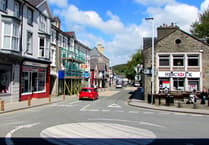Anti-social behaviour has been on the rise across Aberystwyth. But for much of the discussion, residents in the Rheidol Ward have found themselves in the spotlight.
Some residents have said the issues have been ongoing for years, with South Road resident Laurence Akerman stating the anti social behaviour started around 15 to 20 years ago.
One Rheidol resident, 79-year-old Tonwen Edwards, said the “last straw” for her was her door being “kicked in” earlier this month.
In a letter, dated 17 March 2022, to the Police and Crime Commissioner, Dafydd Llewelyn, Tonwen said the issues began, for her, when she moved back to her home in April 2021, after staying at her daughter’s house for the duration of the pandemic.
Tonwen gave details of the incident, which happened at 7pm on 16 March 2022, in the letter: “I felt this incident is the last straw and some action is required before someone is seriously hurt. I am 79 years of age and live on my own, I no longer feel safe in my own home of over 40 years.
“I barricaded my front door on Wednesday in case these boys came back as the wood was damaged around the lock, I did not feel secure and safe in my own home.”
In the letter, Tonwen urges the commissioner to install a CCTV camera from the bottom of Vulcan Street, where it meets High Street.
Tonwen was not the only one to raise CCTV as a potential way to tackle anti-social behaviour. In light of the concerns raised in the third public meeting on the matter, the first of which to be attended by police, Mr Llewelyn committed to reviewing the town’s CCTV infrastructure by the end of April.
This review will consider “the current set up” and whether cameras should be moved, taking into consideration “community concerns” and “professional input from police as to where they would like the cameras to be placed”.
Jordan Phillips, 21, is an Aberystwyth University law student and the grandson of prospective county and town councillor for the Rheidol ward Mair Benjamin.
Jordan said CCTV is a “heavily contested area within the debate” and believed there was too much of a focus on CCTV in the meeting: “It doesn’t necessarily stop a crime from happening; it can be a deterrent though.
“The police can put more cameras up, if this makes people feel safer they can also deploy them themselves as well.”
A consensus that emerged during the meeting on Monday, 4 April, is that there is a desire for greater communication between police, other partner agencies, and residents.
After missing the first two public meetings, organised by prospective county and town Cllr Kerry Ferguson, members of Dyfed Powys Police attended the third meeting – organised by prospective town and county Cllr Mair Benjamin and Mid and West Wales MS Jane Dodds.
The meeting was described as a “step in the right direction” by local representatives.
Ms Benjamin said: “The meeting committed to ensuring multi agency meetings are much more transparent for local residents; that CCTV coverage is reviewed in the next month; that all specific local complaints bought to the meeting will be investigated; that monthly meetings are held between local residents, councillors and the police.”
On their reasons for a lack of attendance prior to the last meeting, Mr Llewelyn said: “If I’m honest I don’t know. Whether there was a miscommunication, whether we were invited or not.
“What happened with me on a personal level is that Ben Lake, the MP, had been to the previous meeting in March. He then contacted me to tell me they were looking to hold another meeting in the future.”
Mr Llewelyn added that the “force may be reluctant to come to meetings” due to purdah, which is why Ceredigion County Council could not attend the third meeting, as well as a lack of availability.
Kerry Ferguson said the third meeting was “productive, in terms of the police being able to see how far the problems stretch”.
She added: “I still think it’s a huge shame that despite my letter in October to all agencies, DPP and CCC asking for cohesion and communication was ignored until March, we still don’t know what happened in the Problem Solving Group in November and it’s taken the involvement of the MP and AM to get some answers.”
Local Inspector Gareth Earp reassured residents, during the meeting on 4 April, that the police have a strong presence in the Rheidol ward: “I am a bit loathed to get into the figures game because if you have one fight on South Road and ten people call it in, it’s one fight but ten calls.
“What I can give you reassurance of, is that the majority of police time in Aberystwyth is spent in the Rheidol ward.
“When you say we’re not there, we are there, when you pick up the phone, we come. We might not always be there straight away, it’s all based on priority. If we’re choosing between people shouting on a beach or CPR on a child, we will always pick the child and I will make no apologies for that.
“Any problems, you can come see me at the police station. If I’m not there, I’ll get back to you.”
Tonwen said, while the police were “trying their best”, there was a need for better communication and more foot patrols.
Others said the 101 reporting service is “failing”, with Mr Llewelyn confirming they were aware “it is an issue”. He added, in 2022, the police are investing £1million in a new telephony system, which they hope will be in place by autumn 2022.
Going forward, Mr Llewelyn said the police wanted more involvement from the community.
Speaking to the Cambrian News, the commissioner said: “It’s important for people to know that, as commissioner, I take an active interest in the security and safety of all residents across all of the force.
“Having regular meetings like this is fantastic, because it gives the unedited view from the public, which the police operationally need to hear and obviously I need to hear as commissioner as well.”
One Central ward resident, who did not want to be named, set up an Aberystwyth neighbourhood watch around two months ago. A month later he, as the coordinator, set up a Facebook group, which has since “exploded”.
The coordinator said: “We are basically extra eyes and ears for the police. We go out on patrol and if we notice anything, we report it. Obviously we can’t get involved ourselves to protect our safety, but we stand from a distance. If it’s something that can be seen in daylight we might record it from a distance.
“We don’t want to become targets ourselves.”
Since setting up the watch, he said others have become involved with the group and many are currently undergoing official neighbourhood watch training.
If you are interested in joining the group, Aberystwyth Neighbourhood Watch, you can find them on Facebook.
While many were pleased with the police’s presence in the last meeting, there is still work to be done in terms of engaging other partner agencies, mainly housing associations and the county council.
Executive Director of the Care Society, which helps to manage the Albion in Aberystwyth, Guy Evans was present.
“It’s a multifaceted problem. Picking up on the housing issue, we have done as much as we can. We don’t have any properties on South Road. There are lots of HMOs, there are good landlords and bad landlords. We need to be ensured they are up to spec and running their properties better.”
Jordan Phillips said: “Our county councillors are relaying stuff that isn’t being heard by the county council. We definitely have licensing issues, residents being woken up by drunken behaviour. This is normal, Aberystwyth is a very young town. That being said, Aberystwyth is for everyone.”
Talking about the rising crime rates in Aberystwyth, Mr Llewelyn said: “In terms of making all the communities in Dyfed Powys safe and secure, that’s what my ambition is. You heard obviously today the meeting has been set up, I’ve ensured that the police have arrived here.
“So we’re all here to listen to the community and ultimately to respond.”
Going out on patrol twice, since December, with neighbourhood policing teams, Mr Llewelyn described his experience as “calm”.
“It might have been the evenings I attended, on a Saturday and Tuesday evening, but it happened to be relatively calm.
“When I was actually here in January, I was actually quite pleased to see so many women actually running on the front of Aberystwyth, all the way past the castle down to the harbour area. It was of an evening, it was dark at night. We talk about safer streets and post Sarah Everard issues, but seemingly in Aberystwyth people do feel safe enough to go running and being out in the community.
“Whether that experience is different to someone who is resident on the streets and in town, day in day out, but my experience was that the town was relatively calm and the officers were giving me feedback to say how motivated they were to respond to the community, be visible and be present.
“That’s one of the reasons, I guess, it’s taken a little bit of time for me to come to this type of public meeting because the initial conversation I was having with the force was that they were seeing things were being responded to.”
Is Aberystwyth really ‘the most dangerous small town in Dyfed?’
ABERYSTWYTH is “the most dangerous small town in Dyfed”, according to a crime statistics website, with figures showing that Carmarthen is “57 per cent safer”.
Sourced data from crimerate.co.uk shows the overall crime rate in Aberystwyth sits at 186.50 per 1,000 inhabitants, the highest among small towns in the Dyfed-Powys force area.
Carmarthen has a crime rate of 118.50.
The website says: “Aberystwyth is the most dangerous small town in Dyfed, and is the second most dangerous overall out of Dyfed’s 199 towns, villages, and cities.
This compares poorly to Dyfed’s overall crime rate, coming in 61 per cent higher than the Dyfed rate of 72 per 1,000 residents.
n For England, Wales, and Northern Ireland as a whole, Aberystwyth is among the top five most dangerous small towns, and the 86th most dangerous location out of all towns, cities, and villages.
October 2021 was a bad month for Aberystwyth residents, when it was Dyfed’s most dangerous area for burglary, recording 11 crimes at a rate of 1.0 per 1,000 residents.
Aberystwyth recorded 12 reports of drugs during August 2021, making its crime rate of 1.1 the worst for drugs in Dyfed that month.
The most common crimes in Aberystwyth are violence and sexual offences, with 978 offences during 2021, giving a crime rate of 91.
This is 38 per cent higher than 2020’s figure of 602 offences and a difference of 34.96 from 2020’s crime rate of 56.
Aberystwyth’s least common crime is bicycle theft, with 7 offences recorded in 2021, an increase of 29 per cent from 2020’s figure of 5 crimes.
nCrimeRate.co.uk is a data analysis and GIS project dedicated to uncovering crime trends in England, Wales, and Northern Ireland.
It aggregates open police force data, social media signals and file FOI requests with local police departments to “build the most complete catalogue of crime and safety information in the region.”




